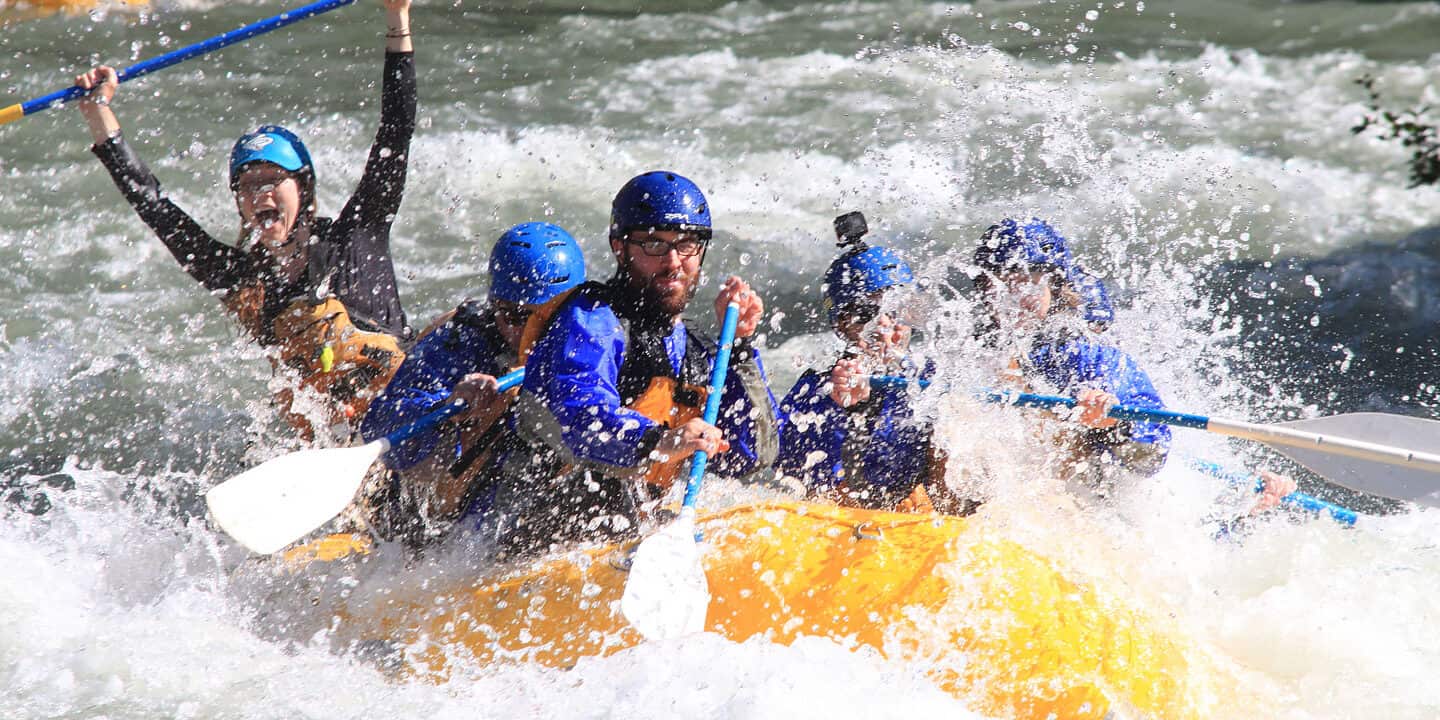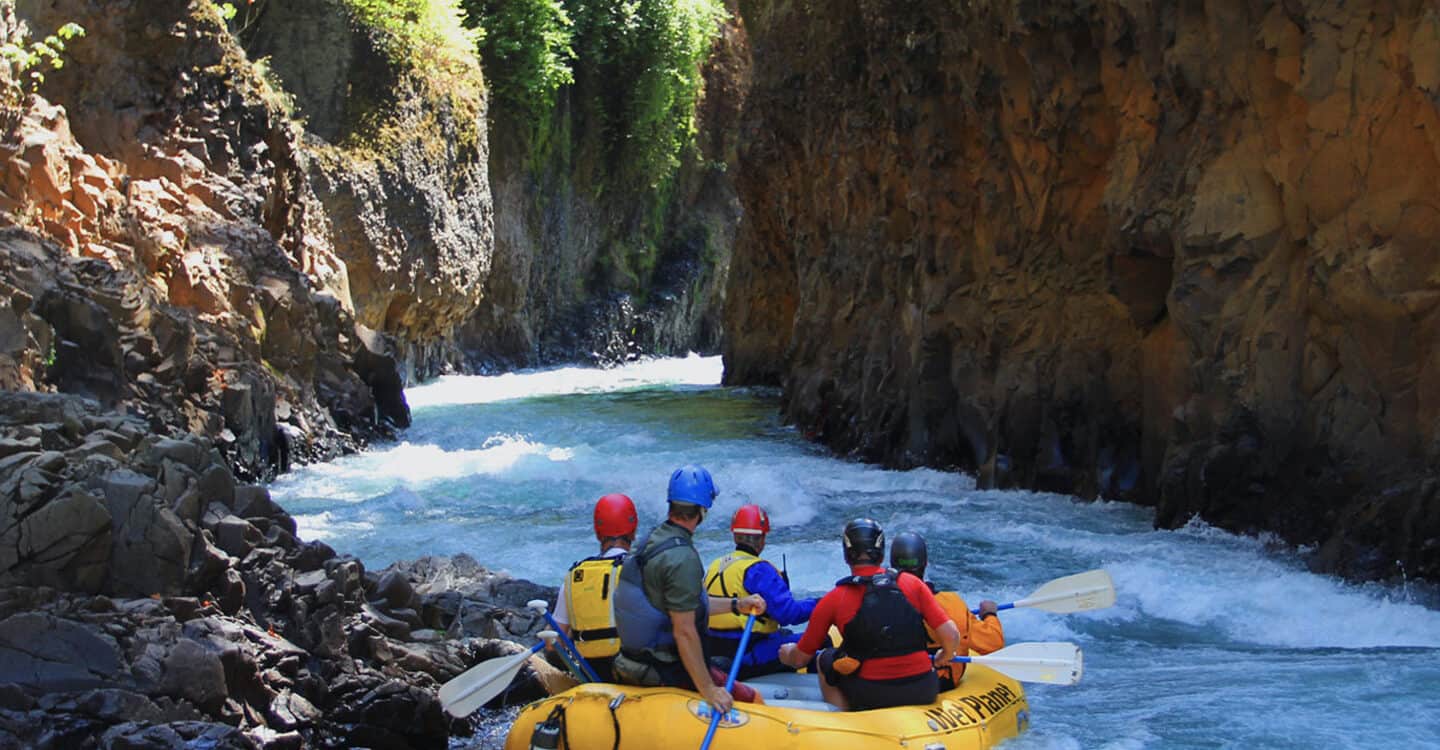Wet Planet has been contracted by JR Merit, the general contractor for all of the work surrounding the removal of Condit Dam, to provide river expertise and advice on log removal and evaluating general boating conditions on the section of the White Salmon River below Condit Dam. To help evaluate river conditions below the dam, or below where the dam used to be, we made two excursions into the “new” Lower White Salmon River. While we haven’t been able to paddle the section of river yet (it’s still closed to boating due to the massive dam removal project underway), Larry Moran from JR Merit did lead us through their construction zone and down into the canyon so that we could view the river from land. The following is a quick report of what conditions look like in the Lower Lower White Salmon River. We took a few photos and have some video of a log in the rapid at the entrance to the Narrows.
This is the entrance to the narrows. It’s beautiful, but it presents a challenge.
First, Larry and the crew from JR Merit are still working hard to complete the removal of the dam. The three of us from Wet Planet (Drew Austel, Tyler Houck, and Todd Collins) were blown away by the size and scope of the project. It’s amazing to see the heavy machinery involved in breaking apart the dam and transporting the concrete up to the old water tube. Those guys are working swing shifts, almost every day of the week, trying to get everything completed on time (September 15th). I’m pretty sure there was a point in our walking trip that the three of us were more fascinated by the actual dam removal process than a chance to see the new rapids in the lower canyon. We had lots of questions for Larry, and he was great about taking the time to answer them and trying to explain the work they were doing. In a nut shell, their in-water work is scheduled to be completed by September 15th. They feel confident that they will hit that deadline. The last pieces of the dam have been broken apart and are being transported out of the river canyon. After the 15th, they will still have on-land work to complete that will involve heavy machinery. So, the river won’t be open for boating for at least a bit after the 15th.
As far as what we saw in the river canyon, I would say that I was generally surprised by how clean the section of river below the dam looked. There was definitely a lot of debris (logs, old pieces of timber, etc.) lying around, but it was much cleaner than I had expected. Other than one significant log jam, which I’ll get to in a minute, everything we saw looked easily passable in a boat. Also, all of the whitewater, with one exception, looked to be class II or easy class III. The best way I could describe it is to say the river pretty much keeps the same characteristic that it currently has in the Northwestern Park area. Similar gradient and similar style whitewater. The one differenece is that the canyon gets deeper and steeper. It’s gorgeous!
We did encounter two significant obstacles to boaters that are worth mentioning.
First, there is an ugly, riverwide log jam in the middle of the Narrows. If you aren’t familiar with the river below the dam, the whole White Salmon River enters a very narrow canyon similar to some of the narrowest spots upstream in the Farmlands. Evidently the water backed up in the Narrows during the dam breach. When the back up finally blew out, there was a mess of logs deposited in the narrowest spot of the canyon. The log jam is very unnatural looking, with logs cemented into sediment pointing upstream at odd angles. It is also very challenging to get a good look at it because the canyon is so narrow and steep. You cannot climb down to it or access this part of the canyon from river level. We were looking down on the log jam from the cliffs above, holding a camera out over the cliff edge to try to take pictures. Since the canyon walls are vertical here, there is also no way to portage if you are actually in the river. We were looking at the log jam when the river was about 3 ft. Our thoughts were that a class V kayaker could probably find a way past it, but it would be sketchy. Generally speaking, the lower canyon isn’t really runnable or portageable while this log jam is still there. At least not at the water levels we were looking at.
Fortunately, JR Merit has plans to use heavy machiner and expertise from the logging industry to remove the log jam. They have the necessary permits in place, and, the last I heard, were planning on attempting to remove it this week. The forest fire raging just up the hill from their construction zone may postpone that work.
The second significant obstacle occurs right at the entrance to the Narrows Canyon. At this spot, there is a rapid that has been historically referred to by boaters as “that Double Drop ledge.” It’s also known to locals as Steelhead Falls. For boaters familiar with the river below the dam, we’ve always known that this ledge rapid would be an issue once the river was returned to its natural flow. I’ll refer to it as Steelhead Falls, although as a result of changes from the dam breach it’s neither a double drop or a falls. Currently, the rapid presents as a single river wide ledge, about four feet high, with a recirculation similar to a low head dam. It is boxed in on both sides. The portage is also challenging, involving some exposed rock scrambling. We looked at this rapid at 3 ft and then again at about 2.25 ft on the Husum gauge. At both levels, it’s a significant rapid.
For us, we were evaluating the river from two different perspectives: the private boater, and commercial trips.
For a private boater, Steelhead Falls is definitely out of character from the rest of the section. It is runnable, but it is also hazardous. It’s also portageable on the left. It should be fairly easy to line a raft around the drop as well. However, boaters should be aware that it’s there. Blindly or accidentally paddling into the ledge hole could have disastrous consequences. The lead-in is a long class III rapid with smaller eddies as you get close to the ledge. Assuming that the river opens to boating in the near future, paddlers should use caution when first running the canyon due to the hazards from this rapid. With the possibility of a portage and/or easy scouting, cautious boaters shouldn’t have too much difficulty figuring out a way around or through this rapid.
From a commercial perspective, we were left scratching our heads. Of the three of us, we were all hesitant to say that Steelhead Falls was commercially viable. The hazard of the hydraulic is significant, and the portage is challenging. We explored a couple of different portage options, including two different routes climbing high out of the river canyon, and didn’t feel like we had a good solution for a commercial raft trip. The problem is that, due to the walled in nature of the canyon here, you won’t be able to run this section of river at all if you can’t get around Steelhead Falls. We didn’t spend a significant amount of time exploring the rapid and portage options, but we definitely saw enough to know that we need to spend more time evaluating Steelhead Falls before we’re ready to plan commercial trips here for Wet Planet.
So, Wet Planet’s plan at the moment for Steelhead Falls: spend more time exploring it once the river is opened up for boating. Running the rapid repeatedly with a group of guides will give us a good idea of how hard we need to paddle to stay on line, the likelihood that someone will fall out, how hard the pourover hits when the raft runs over it, etc. With this information in mind, we’ll be able to decide whether or not we’ll feel comfortable running it commercially. Also, we’ll be able to spend more time exploring options for portaging the rapid if we decide that it shouldn’t be run commercially. While we’re not ready to give the thumbs up for this section of river commercially at the moment, we’re keeping our fingers crossed that we’ll find a good solution for Steelhead Falls once we have the chance to spend more time in the river.
Hopefully that helps with some of the information about the Lower Lower White Salmon River. Thanks to Larry for walking us around and showing us the trails to all the right spots!
Author Todd Collins lives on the White Salmon River in BZ Corner and works year round for Wet Planet.







